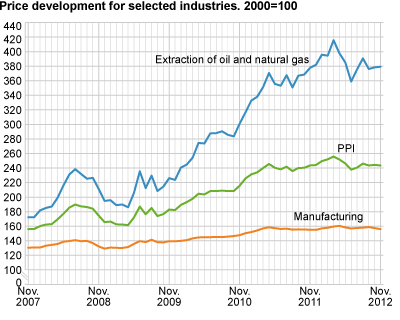Content
Published:
This is an archived release.
Lower manufacturing prices
The producer price index decreased by 0.4 per cent from October to November 2012. The strongest contributions came from decreasing prices within refined petroleum products and basic metals.
Prices within manufacturing fell 0.9 per cent for the second month in a row. As a consequence of a 1.2 per cent drop in the price of crude oil (Brent Blend measured in NOK), prices within refined petroleum products continued to fall from October to November. A decline in the US consumption of goods and hence a fall in manufacturing may have affected the price drop in crude oil.
Basic metals, where prices dropped 1.5 per cent, also had a noticeable impact on the total decrease in PPI. The fall in metal prices was mainly due to lower prices of non-ferrous metals. Prices of mining support service activities and computer and electrical equipment also saw a decrease, by 0.8 and 1.2 per cent respectively.
Higher prices of electricity
A price increase of 0.2 per cent within extraction of oil and natural gas contributed to dampen the total decrease in the PPI. Only natural gas had a price rise from October to November, while the price of crude oil fell in the same period. Higher prices within chemical and pharmaceutical products as well as higher food prices also played a large role in dampening the fall in the overall PPI. Electricity prices went up 1.5 per cent from October to November due to higher prices of electricity sold to Norwegian households.
Unchanged twelve-month rate
From November 2011 to November 2012, the PPI remained virtually unchanged. Compared to October, the twelve-month rate fell 1.7 percentage points. It was mainly basic metals and electricity, where prices fell 4.8 and 12.2 per cent respectively, that contributed to lowering the PPI in the same period. Electricity prices fell partly because of significantly lower temperatures in November 2011 compared to November this year. Prices within refined petroleum products, chemical and pharmaceutical products, as well as extraction of oil and natural gas, all went in the opposite direction, with prices falling 2.3 and 0.4 per cent respectively.
Export prices decreased slightly from November 2011 to November 2012, while prices in the domestic market saw a gentle increase in the same period.
| November 2012 | Changes, per cent | ||||||||||||||||||||||||||||||||||||||||||||||||||||||||||||||||||||||||||||||
|---|---|---|---|---|---|---|---|---|---|---|---|---|---|---|---|---|---|---|---|---|---|---|---|---|---|---|---|---|---|---|---|---|---|---|---|---|---|---|---|---|---|---|---|---|---|---|---|---|---|---|---|---|---|---|---|---|---|---|---|---|---|---|---|---|---|---|---|---|---|---|---|---|---|---|---|---|---|---|---|
| October 2012-November 2012 | November 2011-November 2012 | ||||||||||||||||||||||||||||||||||||||||||||||||||||||||||||||||||||||||||||||
| Total index | 243.5 | -0.4 | - | ||||||||||||||||||||||||||||||||||||||||||||||||||||||||||||||||||||||||||||
| Extraction and related services | 379.3 | 0.1 | 0.4 | ||||||||||||||||||||||||||||||||||||||||||||||||||||||||||||||||||||||||||||
| Manufacturing, mining and quarrying | 156.1 | -0.9 | 0.5 | ||||||||||||||||||||||||||||||||||||||||||||||||||||||||||||||||||||||||||||
| Electricity, gas and steam supply | 231.9 | 1.5 | -12.2 | ||||||||||||||||||||||||||||||||||||||||||||||||||||||||||||||||||||||||||||
| Main industrial groupings | |||||||||||||||||||||||||||||||||||||||||||||||||||||||||||||||||||||||||||||||
| Intermediate goods | 141.3 | -0.1 | -0.7 | ||||||||||||||||||||||||||||||||||||||||||||||||||||||||||||||||||||||||||||
| Investment goods | 128.8 | -0.3 | 0.9 | ||||||||||||||||||||||||||||||||||||||||||||||||||||||||||||||||||||||||||||
| Consumer goods | 133.7 | -0.1 | 0.1 | ||||||||||||||||||||||||||||||||||||||||||||||||||||||||||||||||||||||||||||
| Energy goods | 353.7 | -0.5 | 0.1 | ||||||||||||||||||||||||||||||||||||||||||||||||||||||||||||||||||||||||||||
Additional information
Contact
-
Producer price index
E-mail: produsentpris@ssb.no
tel.: (+47) 21 09 40 00
-
Elisabeth Mælum
E-mail: elisabeth.maelum@ssb.no
tel.: (+47) 97 01 28 49
-
Morten Madshus
E-mail: morten.madshus@ssb.no
tel.: (+47) 40 90 26 94
-
Monika Græsli Engebretsen
E-mail: monika.graesli.engebretsen@ssb.no
tel.: (+47) 40 90 23 71
-
Håvard Georg Jensen
E-mail: havard.jensen@ssb.no
tel.: (+47) 40 90 26 86

